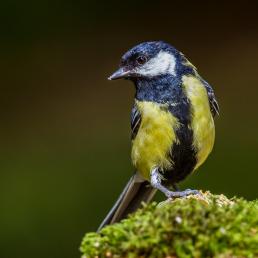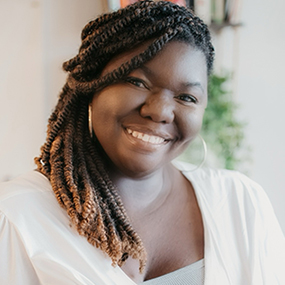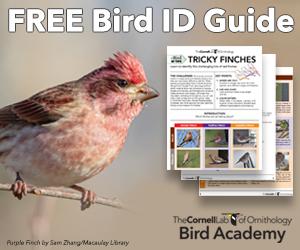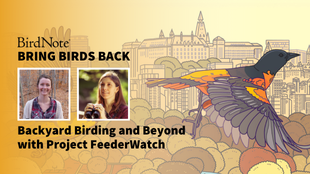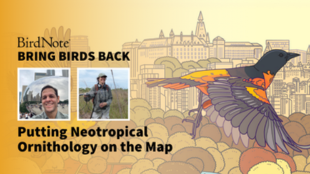

Join BirdNote tomorrow, November 30th!
Illustrator David Sibley and actor H. Jon Benjamin will face off in the bird illustration battle of the century during BirdNote's Year-end Celebration and Auction!
The first of this two-part segment pulls apart the issues with cats and birds. Host Tenijah Hamilton gets an overview of how outdoor cats affect bird populations, why it’s such a controversial issue, and what’s to be done about it. She discusses this with producer Mark Bramhill and guests including “The Cat Daddy,” Jackson Galaxy, and Georgetown University Professor Dr. Peter Marra.
Tenijah Hamilton: BirdNote Presents.
From BirdNote, this is Bring Birds Back. I’m Tenijah Hamilton. And for today’s show, we’re trying something a bit different. I’m joined by our producer Mark Bramhill — hey Mark!
Mark Bramhill: Hey Tenijah! Great to be joining you behind the mic.
Tenijah Hamilton: So, you’ve got something special for us about one of the biggest threats to bird populations, and I have a ...feline...it’s gonna be a little controversial. CAT-traversial, maybe?
Mark Bramhill: I think by now, that the cat is out of the bag here — we are talking about cats vs birds.
Tenijah Hamilton: All right. You know, age old tale, Sylvester versus Tweety. What team do you land on?
Mark Bramhill: Well, that’s kind of why I got interested in this in the first place! I would say I'm right there in the middle. I work for BirdNote, a public radio show about birds — not a surprise that I think birds are really cool, right? But I’m also a huge, huge fan of cats. I really do love both of these animals. And to see that you don't need to look any further than my own cat:
Mark Bramhill: Hey Pigeon!
[Meow!]
Tenijah Hamilton: That was very cute. That did not sound like a bird killer to me at all!
Mark Bramhill: Her name is Pigeon because, uh, well, she's gray. She likes to eat bread crumbs and she kind of, she kind of even does this coo sound.
[Pigeon coo sound]
Mark Bramhill: And even though I keep Pigeon inside, I feel really sad thinking about all cats being kept in doors. Even before the pandemic hit, I, I worked remotely and as I think, many people have learned over the past year and a half, that that can get lonely! And so every day I walk around my neighborhood and say hello to all of the cats.
[Cat meows and purrs play to the rhythm of music]
Mark Bramhill: There’s Tom, Flipper, Rick, River, Raven, Spike, Figaro, Klondike, Axel, Sparkle, Sailor, Sculpin, Jane and Felix.
(I should clarify, not all of them have collars with a name on it, but sometimes a cat just seems like a Felix, you know?)
I make sure to say hello, give them some good head scratches, maybe even a belly rub if they’re in the mood. And honestly, these cats who I get to see wandering around my neighborhood — they just bring me so much joy. Sculpin is the smallest cat I have ever met
Mark Bramhill: Hey Sculpin! You’re so small!
[Sculpin purrrrrr]
Mark Bramhill: Felix, he lives a building down from me, and he comes to my backdoor and does this really raspy meow to get me to come out and pet him. Sometimes I treat him to a little fresh catnip.
[Felix raspy meowing]
Mark Bramhill: He’s a sweet old man.
And there’s little baby Jane, an orange tabby. She’s probably about a year old, and is just so friendly. Like, one time I scratched her ears for a bit, and then she followed me for like 3 blocks — so I walked her back towards her house… only to have her insist on following me again.
Mark Bramhill: Hey buddy!
[Jane meows]
Mark Bramhill: She is the best.
Mark Bramhill: Aw, you’re purring so good!
[Jane purring]
Tenijah Hamilton: There’s so many! You seem like such a pivotal figure. They all just kind of flock around you.
Mark Bramhill: Well, there’s an estimated 30-60 million pet cats allowed to roam about in the US — if you start looking for them, maybe occasionally offering up a treat — I’m sure you’d find bunch of them in your neighborhood too!
Tenijah Hamilton: So you love both of these animals, that is clear as day. You love cats, you love birds… How do you reconcile those two things when it seems like they are mortal enemies. I mean, not to be dramatic, but you know, this is Godzilla vs Kong proportions.
Mark Bramhill: You're not wrong! I mean, like, you know, Pigeon would gladly murder her namesake, you know?
Tenijah Hamilton: Well there you go.
Mark Bramhill: And kind of my answer to how I reconcile is... I try not to. I don't like to think about, kind of the dissonance in that and prefer to avoid thinking about it and just enjoy how cute the cats are and how great the birds are, you know? But more recently, when I learned just how big of an issue it was, I felt like I needed to kind of come to terms with it.
Tenijah Hamilton: I almost shudder to ask, but tell me the numbers. When we're talking about cats killing birds, what's the scale here?
Mark Bramhill: So there's a pretty wide range of estimates between different studies, but everyone agrees that it is a lot of birds: in North America, as many as 1.3 to 4 billion birds are killed by cats every year.
Tenijah Hamilton: Was that “billion” with a “B”?
Mark Bramhill: Yeah, with a “B”!
Tenijah Hamilton: That is a scale to which my brain cannot even comprehend
Mark Bramhill: Yup. And learning that that is the biggest human-caused threat to birds. You know, it felt like something where I just had to learn more and dig more into that. And so I went to someone who really knows a lot about this issue — Dr. Peter Marra. He is a professor of biology at Georgetown University and he’s the author of the book, Cat Wars: the Devastating Consequences of a Cuddly Killer. And he’s also part of the study where they found that 1.3-4 billion dead birds per year figure I talked about earlier. He is definitely a team indoor cat! He actually had one of his own a number of years ago...
Peter Marra: When I was in college I had a cat by the name of Tookus. Kind of an orange tabby. And it was an indoor-only cat, and it was a spectacular pet.
Mark Bramhill: I really love that name, “Tookus!”
Tenijah Hamilton: It’s a very cute-sy name for a cat, but I definitely have a very strong picture of what Tookus might have looked like.
Mark Bramhill:Yeah, a little chunky kinda orange guy?
Tenijah Hamilton: Kinda Garfield-y?
Mark Bramhill:Exactly. I’m sure he loved lasagna. But yeah, back in his Tookus-days, you know, when he was in college and getting his Ph.D., he wasn’t actually thinking about housecats as part of his research. He was actually at the totally other end of the spectrum, you know he wanted “pristine” habitats away from people, as untouched as possible. But when he moved to DC for his job, he realized…
Peter Marra: That the front lines of conservation really are around where people live, in our own backyards.
Tenijah Hamilton: Bam! Right there is the premise of the Bring Birds Back show! Look at us! Go team!
Mark Bramhill: Yeah! Go us! And Marra and some other researchers, they decided to look at a whole bunch of these known to be really big and important threats to birds — you know, wind turbines or window collisions or habitat loss. And they looked at a whole bunch of different studies to try and understand how big of an issue is each one, like relative to each other. Where should we be focussing our time and our energy and what’s going to have that biggest impact.
Peter Marra: And we didn't do this thinking oh cats were going to come out number one. We couldn't believe the numbers that cats were responsible for between 1.3 and 4 billion birds a year. That just blew us away.
Mark Bramhill: After double checking, triple checking, etc. — that’s what they found. And, you know, it’s not exactly a surprise what’s happening: cats are very effective hunters!
Peter Marra: Just like any other animal, they need to be stimulated. And so they need to have enrichment activities. And so when they see something twitching, whether it's a grasshopper, a moth, a vole or a bird, they will try to kill that.
Tenijah Hamilton: So I absolutely understand what Marra is telling me, but… billion? Again, billion with a “b” — it feels still way to hard to comprehend.
Mark Bramhill: Yeah, I definitely get that. For most of us, our only exposure to this is just to a tiny part of it. You know, maybe you have an outdoor cat that brings you back the occasional “present,” but otherwise it’s kind of out of sight, out of mind.
Tenijah Hamilton: That’s so interesting you bring that up, because my partner Ryan, his lovely family cat named Millie. I remember when Ryan and I started dating, and he would go home to see his family, you know, he’d be really excited. He’s like, “oh, I’m gonna get home. I’m gonna be able to, like spend some time with Millie.” It’s really important to him. He’s, like, so into cats. And he’s like, “every morning that i've been home, Millie will just bring a dead bird to my door. And it’s a present. It’s because she’s so excited to see me.” And, uh, seems a little problematic buddy. Uh, Ryan, if you’re listening. Still seems a little problematic.
Mark Bramhill: That’s exactly what I’m talking about. And in fact, studies have found that cats only bring home maybe half of the kills that they make.
Tenijah Hamilton: So we’re just, we’re not even seeing it all? We are not even seeing it all.
Mark Bramhill: Yeah, and multiply that by the number of cats out there… I mean, we are truly seeing just the tip of the iceberg. It sounds like Millie is a pretty, uh, skilled hunter if she’s bringing home a bird every single day. The estimate that Marra and the team he worked with used was more conservative, closer to one bird every week or two. But even that really starts to add up!
Peter Marra: And that's the average, you know, if yours is a particularly effective killer, it might be quite a few more than that.
Mark Bramhill: And as much as I may hate to admit it…
Mark Bramhill: Yeah Pigeon?
[Pigeon Meows]
Mark Bramhill: Yeah?
[Pigeon Desperately Meowing]
My dear Pigeon would be a particularly effective killer.
Mark Bramhill: What do you see?
[Pigeon MEOWWWW]
Mark Bramhill: Ohhh yeah, that robin up there.
[Pigeon ekekekekekekek]
If I let her outside, she would likely have killed more than 100 birds in the time I’ve had her.
Mark Bramhill: Yeah, you wanna get the bird, huh?
[Pigeon brrrra!]
Tenijah Hamilton: That was Pigeon leaving her BTK Killer note. Where she’s like, writing symbols and stuff, trying to let you know that if she had the chance, that robin is not coming home.
Mark Bramhill: Oh yeah. And you know, Pigeon’s inside, so she’s not having that chance, but you know that’s not to mention Tom, Flipper, Rick, River, Raven, Donkey, Sculpin, Jane, Felix… I mean, off the top of my head I can name at least 26 outdoor cats within a quarter mile of my house. Which, that could easily be 1,000 birds each year from those cats alone.
Tenijah Hamilton: Wow. When you start to see these numbers add up… I mean at least for me, it makes those billions of birds make a lot of sense.
Mark Bramhill: For sure. And, over the years, more than 33 bird species have gone extinct at least in part because of cats.
Tenijah Hamilton: Wow. It’s a pretty large scale issue that we’re talking about here.
Mark Bramhill: It really does have just a much wider impact than like I really could have imagined before doing the research for this story. And I know that for a lot of pet-parents, they let their cats outside because they love them. That’s what we’re used to, it feels natural, and they want what’s best for their cat and they’re trying as hard as they can to give them a good life.
Tenijah Hamilton: Nobody is letting their cats outside with the hope that they completely devastate their ecosystem, right? And, just like my partner’s family with their cat Millie, it’s like sometimes you just don’t know the large scale. All of the little pieces that are in play when you make a decision that you think is you know, a reasonably individual one. You don’t think that your one cat is going to cause this mass destruction, or you don’t really consider that your cat is a part of this much larger ecological issue, right?
Mark Bramhill: Oh, definitely. It’s also something where, while being outside can be really enriching for a cat, it can also be really dangerous. Indoor cats live as much as twice as long as pet cats that get to roam unsupervised.
Tenijah Hamilton: Wait, wait, wait, that might be the single biggest piece of information to convert outdoor cat owners.
Mark Bramhill: Definitely.
Tenijah Hamilton: You know the fact that you are elongating their life if you keep them inside?
Mark Bramhill: Yeah, and you know, everyone, whether you are a cat or a bird person, everyone agrees on this. Between disease, getting in fights with other cats, coyotes, other predators, cars and traffic — there are just so many things that can either kill or decrease the lifespan of our pets.
And not too long ago, this hit close to home. I was on an evening walk with my girlfriend. We were going down the street that Jane lives on, she’s the cute little orange tabby. And we noticed a chalk drawing on the sidewalk, it was Jane’s name written out with a little heart drawn around it. And I felt really excited to see this, until I saw a little memorial for her on the tree that was next to it.
There were messages written by some of the neighbors about how sweet of a cat she was, drawings from her family’s kids saying how much they would miss her. From what I understand, Jane had been hit by a car.
Tenijah Hamilton: Aw.
Mark Bramhill: And you know, it just, it didn’t feel possible. You know, I had seen her earlier that week, and she was just a year old, maybe.
Tenijah Hamilton: Oh poor little baby Jane.
Mark Bramhill: And I know this is just a cat, not even MY cat, and I feel kinda silly saying this but it was really devastating to lose her.
Tenijah Hamilton: I mean it seems like Jane meant a lot to the whole community.
Mark Bramhill: Yeah, she was… she was such a friendly cat that just would go up and love on everybody. And, it felt so special to have her outside and part of the neighborhood. But you know, at the same time, as special as that was, I would rather that she be still with us, safe with her family you know?
Tenijah Hamilton: So, I mean that kind of brings me to a question. I know that you’ve said it’s kind of hard to definitively pick one side or the other, especially when you’re thinking about the wellbeing of your cat. Did this shift your opinion kind of, one side or the other definitively about indoor cats?
Mark Bramhill: Yeah, this was really what pushed me from feeling on the fence to feeling we should really keep our cats inside. It’s still hard for me to think about Felix or Sculpin becoming indoor cats. I would be so sad if I don’t get to see them anymore. But I’m increasingly coming to feel it’s what’s best for them. As much as I love getting to see them, I just want to know that they’ll be OK.
Bringing our cats inside, there is an element of their life that is taken away from them. But it’s entirely possible to give them back all of the kind of fun and joy and enrichment that comes from the outdoors. And after the break, we’re going to talk to someone about how to best do that for an indoor cat. We’re going to be talking to the man, the myth, the legend: Jackson Galaxy, the Cat Daddy.
Tenijah Hamilton: Oh boy, cannot wait!
Mark Bramhill: That’s after this.
Tenijah Hamilton: When we're talking about this issue with cats, one of the things that's really hard, and I think is one of the things people sympathize with the most, is the fact that this is quite literally in the nature of cats. It is their instinct to be hunters. And so I'm really interested in the ways that we can mitigate that and at least make it safer
Mark Bramhill: Yeah, they do need that stimulation and that, that kind of enrichment in their lives. And so to kind of find out what can you do for your indoors, to let them live a rich and fulfilling life. I called up a real cat guru.
Jackson Galaxy: My name is Jackson Galaxy. Folks call me the cat daddy.
Mark Bramhill: This is Jackson Galaxy, he is a cat behaviorist and the host of the hit Animal Planet TV show My Cat From Hell. He’s second only to Austin Powers in his unironic use of the word “mojo,” and he’s constantly talking about the importance of encouraging the inner “raw cat.” I am genuinely a huge fan of his. And Jackson agrees that it’s best to keep cats inside, if only to have more years with them.
Jackson Galaxy: It’s alright! It's okay to be selfish. And at the same time, that does take away from their lives in a pretty significant way. They wake up every morning needing to go and kill something. So what do we do?
Tenijah Hamilton: That is intense framing there, that they wake up every morning with Bloodlust. K, great.
Mark Bramhill: When Pigeon jumps on my feet in the morning, I can tell that she's, she’s ready to kill. But yeah, it is something where, bringing a cat indoors, if you don't do anything for your cat, it's not going to be hunky-dory, like it's not going to be a happy cat then. You need to do a lot of enrichment as Jackson describes. And the biggest thing really is just giving them some time and attention
Jackson Galaxy: Number one is committing to a play regimen with them. Not just waving a wand around, it's about committing to the game. You're role playing you know, it's method acting. You are a mouse! You are a bird! Get into it! You know?
Tenijah Hamilton: Oh, method acting!
Jackson Galaxy: Really engaging what I call the raw cat. That cat who wakes up every morning. And if they don't get to hunt, catch, and kill, it does a number on their mojo.
Mark Bramhill: Alright Pigeon, let’s work on your mojo!
Mark Bramhill: 15, 20 minutes a day of playing with your cat — and like, as he says, like really getting into it — for one, it can be a really fun way to bond with your pet. But it also lets your cat be a cat! Chasing a feather wand is still satisfying those same impulses as actually hunting a bird. This is a way to really solve that in a way that is good for everybody.
Tenijah Hamilton: Okay. So it seems like a part of this is just really embracing the fun of hanging out and bonding with your cat. I think folks tend to think of cats as more low maintenance animals than say dogs and cats are really independent and self-sufficient. And so maybe that's not something that everybody does. But it seems like if we embrace that a little more, maybe pull out the laser pointer, point it out a wall for a bit, do some, do some cuddles, some tummy rubs, pop on the Aristocats. I mean, who does not love a good Thomas O'Malley tune. Everybody Wants to Be a Cat.
Mark Bramhill: Definitely. But you know, people have to go to work or run some errands. You know, we can't always be there to play or give them a belly rub or play them some Thomas O'Malley. But your cat can do just fine, making sure that they have something to keep them entertained. And Jackson's answer to that...
Jackson Galaxy: ...is environmental enrichment. We start with the concept of Cat TV: make the windows a destination.
Mark Bramhill: “Cat TV” is Jackson’s name for windows.
Tenijah Hamilton: Ohhh ok. Yep, I get it.
Mark Bramhill: They’re what your cat has to stare at for the day! And you can make them really engaging, make them accessible by putting a cat tree or a bookshelf that they can sit on by the window.
Jackson Galaxy: You can even put bird feeders near the windows. You're giving them that ability to sort of passively engage with their raw self.
Mark Bramhill: Some other things you can do in what Jackson refers to as “catification” of your home is that cats really love high places!
Jackson Galaxy: Making sure that your engaging the vertical space in the home. Give them places to get up and just be themselves,
Mark Bramhill: I've done this with my apartment, putting up a few shelves that lead up to the tall bookcase in my living room. And pigeon is constantly spending time napping up there. And it's clear that like, she really loves having that, especially when she maybe gets stressed out or wants to have some time alone, she can feel really safe and secure up there as though she were climbing a tree.
Tenijah Hamilton: Oh, I love the idea of Pigeon having a little safe place for when she's feeling stressed. I want one Mark, can you build me a person cat-tower? I would like to retreat there as well.
Mark Bramhill: Oh man. I, I love that idea.
Tenijah Hamilton: So, bringing it back to my personal life, because that is what we are all here for, right? When I talk to Ryan, the next time we inevitably get into our outdoor-vs-indoor cat conversation, how do I talk to him about this in a way that isn’t polarizing but also will really encourage him to think about all these issues we’ve talked about? You know, how do we talk to anybody who you know, is thinking about how they might want to transition their outdoor cat to an indoor cat?
Mark Bramhill: I think the biggest thing is you know, lead with that idea of “this is safer for the cat!” Like Jackson said you know, it’s OK to be selfish! It’s OK to want more years with your little fluffy friend.
Tenijah Hamilton: Yeah.
Mark Bramhill: You get more time with your cat, the environment wins… Now, that said you know Millie, she's been an outdoor cat for many many years.
Tenijah Hamilton: Long time, long, long, long, long time.
Mark Bramhill: Both Jackson and Peter Marra and pretty much everyone agrees that it can be really hard to suddenly bring an outdoor cat inside. You know, cats notoriously hate change! So it’s OK to have it not be flipping a switch. Maybe instead you let them out less in the spring where there are lots of helpless chicks.
Tenijah Hamilton: Yeah, fledglings are friends, not food!
Mark Bramhill: Fledglings are friends, not food. Or maybe even just have your next cat be an indoor cat! It doesn’t have to be all or nothing.
Tenijah Hamilton: So that is great and everything, but I do want to say, I’m starting to see this phenomenon of folks on my Instagram feed taking their cats on walks using leashes, like you would a dog.
Mark Bramhill: Mhm!
Tenijah Hamilton: And um, you know, something you mentioned, you were like “uh cats are not that amenable to you know, to change and to these new things.” But I’m just saying, the cats that I see look like they’re having the time of their nine lives.
Mark Bramhill: Absolutely, I know exactly what you’re talking about. And actually, this is something that is really big for Jackson as well. For people to be able to give their cats supervised outdoor time.
Jackson Galaxy: the last big one is harness training your cat, taking them out for walks, not really walking half the time, they're just exploring, but that's great! And harness training is not as hard as folks think it is.
Mark Bramhill: I’ll admit I was skeptical of that last part, uh, that it's not that hard.
Tenijah Hamilton: He did not sell that. Cats are pretty willful. They're pretty opinionated. And they have no problem letting you know when something is a NO for them. So what, yeah. How does this even happen?
Mark Bramhill: Yeah, so I thought I needed to put this to the test with Pigeon. And I asked him for advice on how to do that.
Jackson Galaxy: the hardest part is getting them to be somewhat comfortable with this feeling of a vest around their entire body. That consistent pressure. Don't even attempt to take them outside until they can walk around the house as if they don't have anything on them.
Mark Bramhill: Alright Pige, let’s work on your vest...
Jackson Galaxy: You know, the first time you do it, your cat might just stop walking.
Mark Bramhill: No, Pigeon n–
[Loud sound]
Jackson Galaxy: They might flop over on their side
[Thud]
Mark Bramhill: Oh, no OK. Training’s over.
Jackson Galaxy: They might try to back out of it constantly.
Mark Bramhill: Oh OK come back… come ba— oh… dammit. OK. Come here.
Mark Bramhill: To make this smoother — you reward your cat with treats
Jackson Galaxy: Put it on, they take a few steps, killer, wonderful treat, treat, treat, take it off.
Mark Bramhill: And after some trial and a lot of error
Mark Bramhill: OK you’re walking around, good! We’re coming in for a treat! Aw yeah…
[Pigeon purrs and eats treat]
Mark Bramhill: You’re warming up to this thing, huh?
Jackson Galaxy: The next step is introducing the leash.
Mark Bramhill: Some more flops here, but soon she was wearing her walking jacket and leash like a champ.
Jackson Galaxy: And after you can walk them around the house with the leash and harness. It’s time to go outside.
[Sound of screen door opening]
Mark Bramhill: All right
[Pigeon meows]
Mark Bramhill: She clearly loves it. She gets so excited to walk on like the grassy little hill in my backyard and just sniff all the flowers and just wander around.
Mark Bramhill: Yeah, you like exploring?
[Pigeon meows]
You can just tell that she is like…
Tenijah Hamilton: ...living her best life?
Mark Bramhill: Absolutely, living her best life.
Tenijah Hamilton: I love that. You have all this great love for all the outdoor cats that you kind of encounter on your walks and Pigeon can kind of enjoy that too. Pigeon can be an outdoor cat, within reason, safely. And that, that really actually warms my heart.
Mark Bramhill: It's really special to give that to her while still knowing that, you know, she's safe, the birds I see in my backyard are safe. And it feels like… everybody wins.
Tenijah Hamilton: Harmony. That's what that sounds like.
Mark Bramhill: We'll put, we'll put like a little angel, angel choir here.
Mark Bramhill: Okay I actually have to pull the choir.
Tenijah Hamilton: Nooo, the angel choir was so nice, come back!
Mark Bramhill: There's another big, really important part of this issue. All of the cats that are outside that don't have a food bowl and a little cat bed to come home to. There are those feral and stray cat colonies out there, and they actually make up a majority of those bird deaths. And there isn't, you know this win-win super positive solution. It's not as simple as we bring our cats inside and we give them a lot of love, play them some Thomas O’malley and everyone’s happy. And this is where the debate can get really ugly.
There's a lot to talk about. So next time we are going to dive deeper into the world of cats and birds. We’re going to visit an island of feral cats, look into the different controversial solutions to this problem… and we're going to go on Portland's catio tour.
Tenijah Hamilton: Well I did not go on the catio tour, and I am very sad about this because that seems like a life goal right there. I, to, would like to go and hang out with the cats. You hear me?
Mark Bramhill: I’ll make sure you get an invite next time, I promise.
Tenijah Hamilton: Next time. Mark, this has been truly enlightening. And I appreciate you being here today, in front of the microphone.
Mark Bramhill: Thank you so much Tenijah, this has been really great.
Tenijah Hamilton: Bring Birds Back is produced by Mark Bramhill and me, Tenijah Hamilton. Today’s episode was edited by Ashley Ahearn and Oluwakemi Aladesuyi. Our content director is Allison Wilson. Our lead science advisor is Trina Bayard. Music is by Cosmo Sheldrake and Blue Dot Sessions. Special thanks to Cynthia Chomos, Courtney Dolliver, and Rehka Murthy.
And of course, many thanks to our season sponsor, the Cornell Lab of Ornithology. Check out all they have to offer, like Bird Academy online courses and the Merlin ID app, at ALL ABOUT BIRDS DOT ORG.
And we want to hear from y’all in the Bring Birds Back flock! What do you do with your cat? Have you tried taking them for a walk? Do you have a friend who has an indoor-outdoor cat, and you’re not sure how to talk to them about it? Is that person you? Do you have an indoor-outdoor cat and you’re feeling conflicted about what to do next. Record a voice memo on your phone and email it to us, at Bring Birds Back AT BirdNote DOT org. You might be featured on our next episode.
Thanks for listening — see y’all next time
Bring Birds Back is sponsored by the Cornell Lab of Ornithology.
Well-known in pop-culture as "The Cat Daddy," Jackson Galaxy is the host and executive producer of the renowned Animal Planet series, "My Cat From Hell." Jackson is a cat behaviorist and wellness expert, who has been working with cats and their guardians for over 25 years. He is also a New York Times best-selling author, having penned popular books such as Total Cat Mojo and Catify to Satisfy, which can be purchased on his website, https://www.jacksongalaxy.com.
Peter P. Marra is the Director of the Georgetown Environmental Initiative (GEI), Laudato Si’ Professor in Biology and the Environment, and Professor in the McCourt School of Public Policy. Prior to Georgetown, Pete spent 20-years at the Smithsonian Institution, most recently as Director of the Migratory Bird Center. He has published over 250 papers and two books on various aspects of the biology and conservation of birds and other animals.
